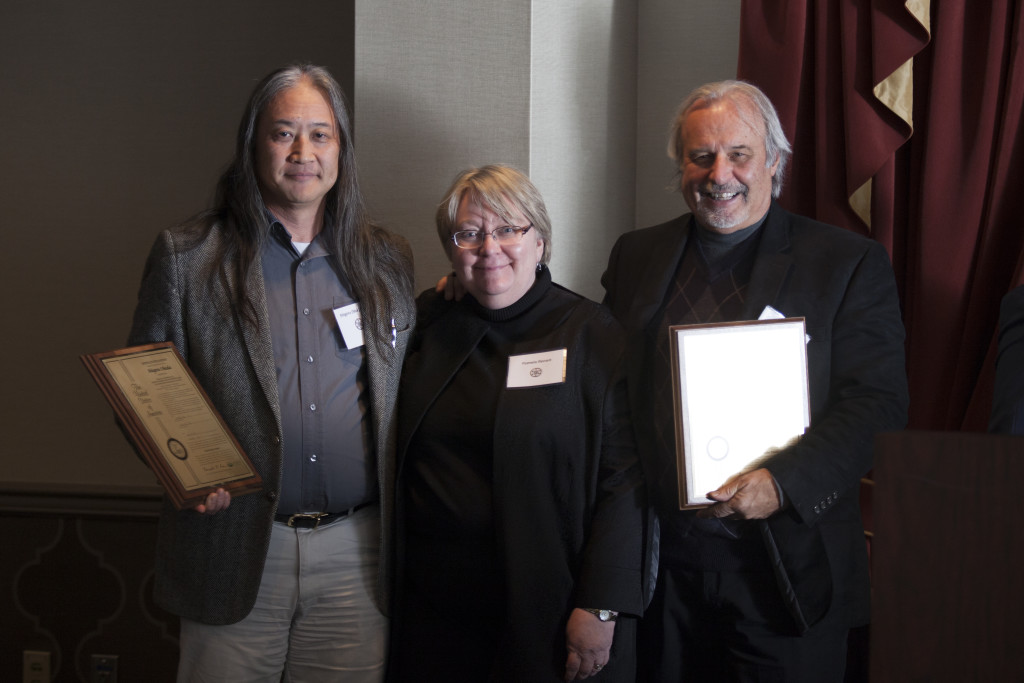Ohio University honored 78 faculty, staff and student inventors for work in areas ranging from drug development to environmental remediation technologies during an awards ceremony Feb. 10.
The Inventors Dinner recognized individuals who had received a patent, filed for a patent or disclosed a new invention through the university’s Technology Transfer Office, which is charged with protecting intellectual property and commercializing innovations developed by the faculty and research staff.
Ohio University has a successful track record in commercializing technologies. The university ranks first among Ohio higher education institutions for research licensing revenue, with faculty inventions generating $10.6 million during fiscal year 2014, according to a report from the Association of University Technology Managers (AUTM).
“From developing transportation technologies that can improve roadways to making laboratory discoveries that may lead to new medical therapies, Ohio University faculty, staff and students are engaged in a wide variety of research projects that can have a positive impact on society,” said Joseph Shields, vice president for research and creative activity and dean of the Graduate College. “The university is dedicated to providing services and support that can help these inventors move their novel ideas and findings from campus to the marketplace.”
Ohio University received 11 patents for inventions in 2015. Among those included member faculty of the Interdisciplinary Graduate program in Molecular and Cellular Biology.

Ohio University Executive Vice President and Provost Pamela Benoit, center, with inventors Shigeru Okada, left, and John Kopchick, right. Photo: Kaitlin Owens.
1) “Growth Hormone and Interferon-alpha 2 Glycoproteins Produced in Plants,” Marcia Kieliszewski (Department of Chemistry & Biochemistry, MCB), John Kopchick and Shigeru Okada ’93 (Heritage College of Osteopathic Medicine/Edison Biotechnology Institute, MCB ). This innovation is related to making therapeutic proteins that are relatively short-acting in the body (once-a-day injections) into longer-acting therapeutic proteins (once-a-week injections).
2) “Compositions and Methods for Treating Biofilms,” Tingyue Gu (Russ College of Engineering and Technology, MCB) and Dake Xu (Russ College of Engineering and Technology). This patent addresses an improved approach to controlling corrosion from microorganisms in areas such as pipelines and water systems.

Executive Vice President and Provost Pamela Benoit, center, with inventors Stephen Bergmeier, left, and Xiaozhuo Chen, right. Photo: Kaitlin Owens.
3) “Compositions and Methods for Glucose Transport Inhibition,” Stephen Bergmeier (Chemistry and Biochemistry, MCB) and Xiaozhuo Chen (Heritage College of Osteopathic Medicine/Edison Biotechnology Institute, MCB). Disclosed in this patent are compounds of formula for the treatment of cancer. These compounds reduce and inhibit the uptake of glucose by a cancerous cell, which will initially result in the slowing of cell growth and eventual cancer cell death.
4) “Nucleic Acid for Plant Expression of a Fusion Protein Comprising Hydroxyproline O-Glycosylation,” Marcia Kieliszewski (Chemistry and Biochemistry, MCB). This patent covers injectable pharmaceutical formulations comprising glycosylated human growth hormone.
In addition, 57 faculty, students and staff filed for patents on their inventions in 2015, and 34 individuals disclosed new inventions to the university.
Invention disclosure is the first step in the technology commercialization process. Technology Transfer Office staff review these disclosures to determine if the intellectual property can be patented and licensed for commercial use. If so, the office files for patent protection with the federal government, and works with inventors to identify licensing opportunities that can develop the technologies into useful products for the marketplace.
In addition, the Technology Transfer Office works closely with the university’s high-tech business incubator, the Innovation Center, and its state Entrepreneurial Signature Program, TechGROWTH Ohio, to connect inventors to business coaches and sources of seed funding that can help them launch startup companies if appropriate.
For more information about the Ohio University Technology Transfer Office, visit www.ohio.edu/research/tto.
MCB Faculty Recognized for Patents Filed:
Stephen Bergmeier, Chemistry and Biochemistry, MCB
Douglas Goetz, Chemical and Biomolecular Engineering, MCB
Yang Li, Biomedical Sciences, MCB
Kelly McCall, HCOM Specialty Medicine, MCB
Mark McMills, Chemistry and Biochemistry, MCB
MCB Faculty, Alumni and Students Recognized for Invention Disclosures:
Karen Coschigano, HCOM Biomedical Sciences, MCB
Yang Li, HCOM, Biomedical Sciences, MCB
Kelly McCall, HCOM Specialty Medicine, MCB
Lingying Tong Edison Biotechnology Institute and MCB Alumni
Debra Walter, PhD Candidate MCB
Shiyong Wu, Chemistry and Biochemistry, EBI, MCB




















Comments